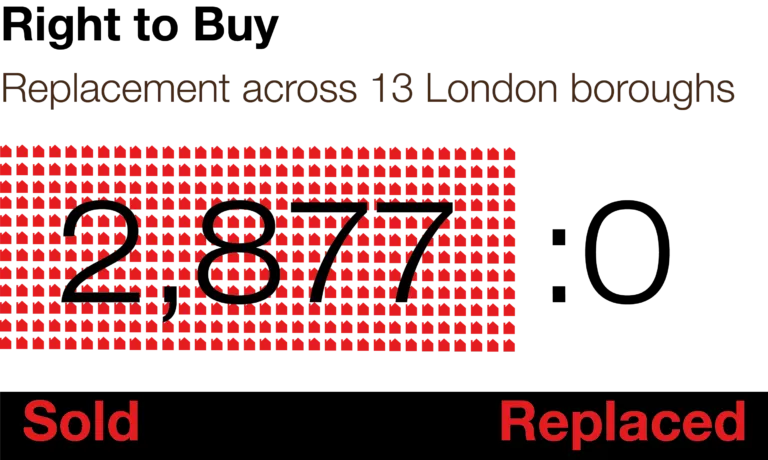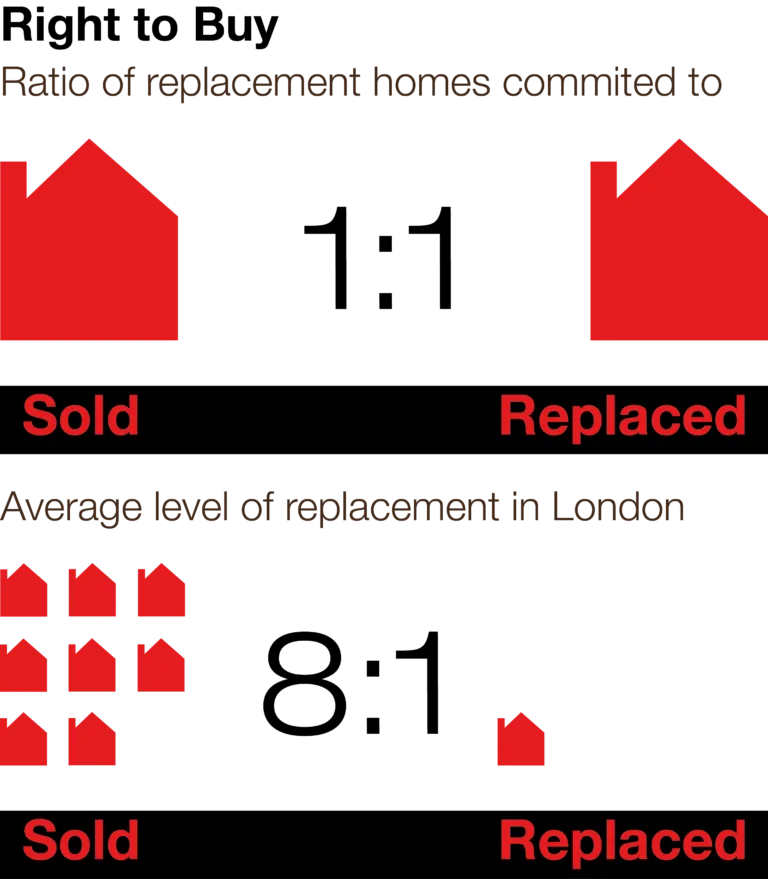Right to Buy one-to-one replacement falling short in London
Published: by John Bibby
The commitment to build a replacement for every social rented home sold through the Right to Buy scheme is not being fulfilled in London, just as across the country. In 13 boroughs there have been exactly no replacement homes built for the 2,877 social rented homes sold.
We wrote recently about the national failure to replace social rented homes sold through Right to Buy. Back in December 2011, when the government increased the discounts available to tenants, they said that the revitalised scheme would “ensure every home sold is replaced”.[i]
The commitment to replace the sold homes was about as solid a commitment as they come. The announcement stated that:
“Ministers are committed to ensuring that there is no reduction in the number of affordable homes – so for the first time any additional home bought under the scheme will lead directly to the provision of a new affordable home for rent on a one-to-one basis.”
But since the commitment was made 26,184 social rented homes have been sold through Right to Buy across England and only 2,712 replacement homes either started or bought. The ratio of replacement has been ten homes sold for every one replaced, nowhere near one-to-one.
Of course it can take a bit of time to build a home, so we should expect a bit of lag in the statistics; but it’s important to remember here that we’re talking about housing starts, when work begins onsite, rather than housing completions – when the home is finished.
Right to Buy has always been particularly controversial in London due to the relatively large number of homes still in council ownership, huge number of people waiting for a social rented home, the typically high value of the homes bought cheaply by tenants, and the number of Right to Buy homes that end up in a poor condition in the private rented sector.
Just as in the rest of the country replacement in London is nowhere near approaching one-to-one replacement.
Across the city 6,973 social rented homes have been sold through Right to Buy since the discounts were increased and 825 replacements started or bought. While that still leaves a gaping shortfall of over 6,000 unbuilt homes, the ratio of sales to replacements is eight-to-one.
But using averages disguises the wide divergence across the capital in the level of replacements for homes sold through Right to Buy. Because while in some parts of London replacements are being built, in others there is nothing at all. So in one borough (Barking & Dagenham) the number of replacements approaches the one-to-one that was committed to, but in 13 there’s not been a single replacement.
At 2,877, the Right to Buy sales in these 13 boroughs accounts for nearly half of total London sales, but not one home has been started or bought to replace social rented homes lost. That’s a replacement ratio of 2,877-to-zero in boroughs that, together, have almost 100,000 people and families waiting for social rented homes (a full table with all the stats is reproduced below).
London’s not alone in having large pockets where barely any replacement homes are being built at all. In Manchester, despite 598 Right to Buy sales, only 2 replacement homes have been started. In Kent, despite 257 sales, there have been only 10 replacements.
It’s easy to get lost in the numbers when we talk about affordable housing, but it’s important to see this failure in context and to understand its implications.
The context in London is particularly bleak. In recent years, the number of people getting a raw deal in the private rented sector has swollen across the capital. Homelessness has increased. And social house building across parts of London has ground to a complete stop, reflecting the national trend.
The failure to replace homes sold through Right to Buy will likely mean a continuation of this trend. A third of Right to Buy homes end up in the private rented sector. Without replacements, the private rented sector will increasingly be the only option for the most vulnerable Londoners. For those who can’t access or afford private renting, the result will be homelessness.
The solution to all of this is clear; it’s building more genuinely affordable homes. And that starts with sticking true to one-to-one replacement.
Detailed borough-by-borough breakdown of Right-to-Buy replacements
| Borough | Replacements started | RTB sales | Sales for each replacement | Social housing waiting list |
| Barking and Dagenham | 417 | 488 | 1 | 11,024 |
| Barnet | 3 | 229 | 76 | 1,045 |
| Bexley | NA | NA | NA | 3,481 |
| Brent | 0 | 168 | zero replacement | 5,102 |
| Bromley | NA | NA | NA | 3,126 |
| Camden | 21 | 195 | 9 | 22,409 |
| City of London | 0 | 23 | zero replacement | 476 |
| Croydon | 0 | 175 | zero replacement | 5,102 |
| Ealing | 0 | 274 | zero replacement | 10,676 |
| Enfield | 37 | 287 | 8 | 2,237 |
| Greenwich | 0 | 567 | zero replacement | 11,375 |
| Hackney | 70 | 203 | 3 | 7,926 |
| Hammersmith and Fulham | 0 | 130 | zero replacement | 433 |
| Haringey | 0 | 383 | zero replacement | 9,203 |
| Harrow | 0 | 81 | zero replacement | 687 |
| Havering | 6 | 212 | 35 | 2,271 |
| Hillingdon | 0 | 308 | zero replacement | 3,606 |
| Hounslow | 5 | 154 | 31 | 6,842 |
| Islington | 61 | 345 | 6 | 17,860 |
| Kensington and Chelsea | 13 | 54 | 4 | 2,677 |
| Kingston upon Thames | 0 | 77 | zero replacement | 6,436 |
| Lambeth | 0 | 258 | zero replacement | 15,264 |
| Lewisham | 14 | 220 | 16 | 8,294 |
| Merton | NA | NA | NA | 7,625 |
| Newham | 19 | 372 | 20 | 15,582 |
| Redbridge | 3 | 133 | 44 | 7,804 |
| Richmond upon Thames | NA | NA | NA | 4,008 |
| Southwark | 21 | 556 | 26 | 13,436 |
| Sutton | 0 | 163 | zero replacement | 1,496 |
| Tower Hamlets | 100 | 284 | 3 | 20,425 |
| Waltham Forest | 0 | 270 | zero replacement | 20,635 |
| Wandsworth | 25 | 251 | 10 | 2,788 |
| Westminster | 10 | 112.88 | 11 | 4,378 |
| London total | 825 | 6,973 | 8 | 11,024 |
[i] It’s worth noting from the off that while there was a commitment to replace the homes, the replacement was never for like-for-like replacement. Every social rented home sold was to be replaced with an Affordable Rent home, which have rents of up to 80% of market rents, compared to social rents of roughly 50% market rent.


